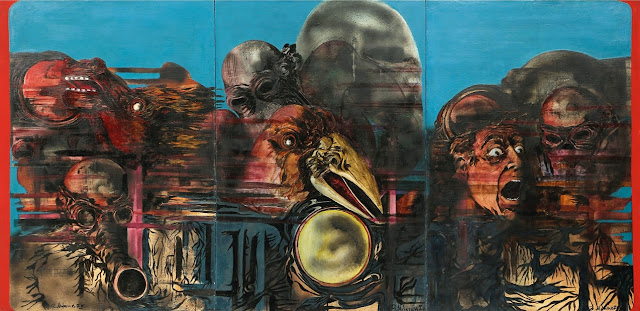BAHMAN MOHASSES, 1931-2010, Iranian
TIRESIAS NON SAPEVA TANTO DEL FUTURO/ TIRESIAS DIDN'T KNOW MUCH ABOUT THE FUTURE, c. 1970
Oil on canvas, in three parts
100 by 210 cm.; 39⅜ by 82⅝ in.
Private collection
In Greek mythology, Tiresias was a blind prophet of Apollo in Thebes, famous for clairvoyance and for being transformed into a woman for seven years. He was the son of the shepherd Everes and the nymph Chariclo. Tiresias participated fully in seven generations in Thebes, beginning as advisor to Cadmus himself.
Eighteen allusions to mythic Tiresias, noted by Luc Brisson, fall into three groups: one, in two episodes, recounts Tiresias' sex-change and his encounter with Zeus and Hera; a second group recounts his blinding by Athena; a third, all but lost, seems to have recounted the misadventures of Tiresias.
Among the ancient authors who mention him are Sophocles, Euripides, Pindar, and Ovid. More on Tiresias
Bahman Mohassess (March 1931 Rasht, Iran – 28 July 2010 Rome, Italy), dubbed by some as the "Persian Picasso", was an Iranian painter, sculptor, translator, and theatre director. His oeuvre comprises paintings, sculptures and collages. He was also a celebrated translator of literary works. His works are highly collected and extremely rare. He is said to have destroyed many of his own works, and those that become available at auction are now highly sought after.
At age 14 he learned painting by apprenticing with Seyyed Mohammed Habib Mohammedi, who had studied at the Russian Academy of Arts. He moved with his family from Rasht to Tehran, where he attended Tehran's Faculty of Fine Arts. During the same period he joined the "Cockfight Art and Culture Society", established by Jalil Ziapour, and was, for some time, the editor of the literary and art weekly "Panjeh Khoroos" (Rooster Foot). Through this period, he was part of an avant-garde artistic movement, who were all considered progressive artists of their time. In 1954 he moved to Italy to study at the Fine Art Academy of Rome.
He returned to Iran in 1964 and participated in Venice, São Paulo and Tehran Biennale. Mohasses directed plays, including Pirandello's Henry IV at Goethe Institute and Ghandriz Hall in Tehran. He also translated books of a number of authors,.
He stayed in Iran until 1968, before returning to Rome 1954, where he received commissions for statutes to be placed in Tehran. Some of his public works in Iran were destroyed or damaged after the Islamic Revolution, with the artist subsequently destroying all his remaining works in Iran. He occasionally travelled to Iran and died in self-imposed seclusion in Rome in 2010. More on Bahman Mohassess
Please visit my other blogs: Art Collector, Mythology, Marine Art, Portrait of a Lady, The Orientalist, Art of the Nude and The Canals of Venice, Middle East Artists, 365 Saints, 365 Days, and Biblical Icons, also visit my Boards on Pinterest
Images are copyright of their respective owners, assignees or others.
Some Images may be subject to copyright
I don't own any of these images - credit is always given when due unless
it is unknown to me. if I post your images without your permission, please tell
me.
I do not sell art, art prints, framed posters or reproductions. Ads are
shown only to compensate the hosting expenses.
If you enjoyed this post, please share with friends and family.
Thank you for visiting my blog and also for liking its posts and pages.
Please note that the content of this post primarily consists of articles
available from Wikipedia or other free sources online.

No comments:
Post a Comment